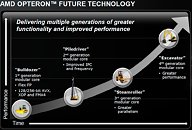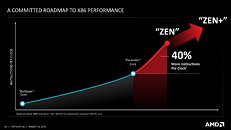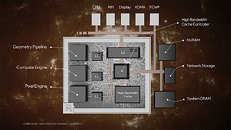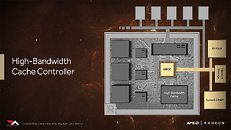Sunday, January 8th 2017

AMD Says "ZEN" CPU Architecture is Expected to Last 4 Years
After spending almost 4 years developing and perfecting (as much as can be perfected in such an amount of time) it's ZEN CPU architecture, AMD is looking to extract some mileage out of it. Mark Papermaster, AMD's chief technology officer, confirmed the four-year lifespan in a conversation with PC World at CES 2017 in Las Vegas, though he declined to discuss specifics. When asked how long ZEN would last (especially comparing to Intel's now-failing two-year tick-tock cadence, Papermaster confirmed the four-year lifespan: "We're not going tick-tock," he said. "ZEN is going to be tock, tock, tock."Intel's tick-tock cadence has typically meant that it develops a new micro-architecture every two years (tock), with a process improvement in-between architectures (the tick). Of these, Kaby Lake is the first exception, ushering in a second "tick" moment for the company, which leveraged what it calls its "14 nm +" manufacturing process. AMD, on the other hand, has typically drawn more than 4 years worth of products from most of its micro-architectures (even Bulldozer has lasted from late 2011 until now), with AMD focusing in incremental updates in-between major architecture launches (such as Bulldozer's Piledriver, Steamroller, and Excavator updates).On Papermaster's words, it seems AMD is planning to iteratively improve its Ryzen chips through some additional generations - whether at the cadence of their Bulldozer architecture or not, remains to be seen, but it can be expected that that will be the case. What those improvements will be, of course, are for now anyone's guess. But Papermaster also said he's a believer in architecture improvements that go beyond simple manufacturing - something he's previously referred to as "Moore's Law Plus."In interviews, Mark Papermaster referred to this as the industry's failure to achieve Moore's law through transistor shrinking alone - as had been historically the case. Moore's Law Plus means that chipmakers will have to find creative, less-streamlined ways of inching closer to what Moore's Law (in its Intel's David House coating, who predicted that chip performance would double every 18 months) stipulates. According to Papermaster, "It will be ingenuity at the system level to put solutions together. It might be combinations of CPU and GPU, other accelerators, different memory configurations, how they're pieced together - there's room for lots of innovation at the next level."We're actually seeing hints of that with AMD's upcoming VEGA architecture's additions of a High-Bandwidth Cache (HBC) and an High-Bandwidth Cache Controller (HBCC): of which you can have an excellent read right here at TechPowerUp. How this will translate with the CPU side of the equation, and what this means for AMD's ZEN or forthcoming CPU architectures, however, remains to be seen.
Source:
PC World






70 Comments on AMD Says "ZEN" CPU Architecture is Expected to Last 4 Years
The title kinda also says four years, not six.
And believe , Intel know this they have used most their r and d time trying to crack mobile in the last 8 years.Fair enough:).
As I said, we saw two systems, one intel octo, and Ryzen octo...both had titans. The FPS between the two were very close. I couldn't test empirically, but it's fair to say they have overcome their glass ceiling syndrome on high end cards.
Perhaps that makes it less weak? ;)
@64K
Because amd's best offer was FX 9590 With 220 W TDP that can not compete with Haswell based i3
The shrinks are also LITERALLY a change in architecture. Maybe Intel should have just picked a different naming scheme and people wouldn't complain?
1. "So much talk so little benchmarks" Benches have been shown at conference; and leaks of ES. (So what you would say is; when will the COU be out for reviews (that I await as well.) )
2. "AMD 4 years" :What the other dude said (you dont understand what you are talking about.)
3. "core2duo" why would that EVER have ANY relavance?!?! Somewhere some still uses my TI-84 but that doesnt make it a 8C16T CPU.
To be honest, whether its using finer processes, or new architectures, the end result is making money; how else would such an expensive enterprise survive without making money?
Main point was they did multiple shrinks with a nearly identical uarch and nodes mean poppy cocks when talking about raw perf.
They were perfectly content letting netburst play out for many more years up to several GHz with shrinks. Can you imagine the absurdly terrible performance we'd have today?
If you're happy with Sandy Bridge then don't upgrade, whatever, nobody is forcing you to.